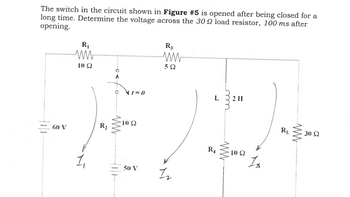
Delmar's Standard Textbook Of Electricity
7th Edition
ISBN: 9781337900348
Author: Stephen L. Herman
Publisher: Cengage Learning
expand_more
expand_more
format_list_bulleted
Question
final answer is 21.3141 volts so work towards that answer

Transcribed Image Text:The switch in the circuit shown in Figure #5 is opened after being closed for a
long time. Determine the voltage across the 300 load resistor, 100 ms after
opening.
R₁
ww
1052
R3
ww
ΣΩ
60 V
R₂
°
x7=0
ww
102
50 V
12
L 22H
ww
R+
www
102
Iz
RL
ww
30 52
Expert Solution
This question has been solved!
Explore an expertly crafted, step-by-step solution for a thorough understanding of key concepts.
Step by stepSolved in 2 steps with 4 images

Knowledge Booster
Similar questions
- If the charging resistor was twice as large as the discharging resistor in Figure 4, theamplitudes of the charging and discharging waveforms would be ________.a. The sameb. Differentarrow_forwardWith V1, voltage peak to peak is 10 volts, R1=200 Ohm, R2=1000 Ohm and C1= 300 nF. Find Vx, voltage across the the capacitor, C1 and R2 when the frequency is 1000 Hz and 10000 Hzarrow_forwardIf a circuit has a resistance of 3002 and a series inductance of 5002, what is the relationship between the applied circuit voltage and the circuit current? The applied voltage lags the circuit current. The phase shift between the circuit voltage and current changes with time. The applied voltage is in phase with the circuit current. The applied voltage leads the circuit cur Previous Page Next Page Page 2 of 10arrow_forward
- Consider the RC circuit in Figure 2 below. Assuming the switch has been open for a long time before it is closed, fill in a table providing the current through each component and the voltage across each component immediately after the switch is closed, and a very long time after the switch is closed. Next, figure out the time constant for the circuit. (Hint: Assign currents to each branch. Set up the necessary KVL and KCL equations. Eliminate all but one variable to get an equation for just one of the currents. You shouldn’t have to solve this equation to recognize the time constant!)arrow_forwardCalculate the RMS current through R2 in the diagram IR1 = 6.06mA peak, R2 = 2.7 kohms, total current is 9.522mA RMS 3.25mA RMS 5.24mA RMS 7.41mA RMS 9.0mA RMSarrow_forwardFor the series RL circuit shown in the figure below, answer the following questions and justify your answer.If the current is kept constant, does the coil have inductance?If the current is kept constant, does the coil affect the current value?Can the reverse emf ever be greater than the battery emf?arrow_forward
- Subject to a step input, the voltage drop across the resistor took 696.3103us to reach 13% of its steady value from rest. Determine the time (ms) needed to reach 90% of its steady value from 10% Determine the time (ms) needed to reach 80% of its steady value from 20%arrow_forwardElectrical Machine question.arrow_forwardHello I need help solving this for the left and right side of this circuit. I have also provided a picture for reference.arrow_forward
- a Moving to another question will save this response Question 11 Mutual inductance between an infinite current fliament placed along y-axis and rectangular coil of 1800 turns placed in x -y plane as shown in figure will be (6, 1, 0) 0.396mH None of choices 0.264mH 0.33mH Windows buarrow_forwardA 15-F AC capacitor is connected in series with a 50 resistor. The capacitor has a voltage rating of 600 WVDC. The capacitor and resistor are connected to a 480-V, 60-Hz circuit. Is the voltage rating of the capacitor sufficient for this connection?arrow_forwardTOPIC: STABILITY Subject to a step input, the voltage drop across the resistor took 696.3103us to reach 13% of its steady value from rest. Determine the time (ms) needed to reach 90% of its steady value from 10% Determine the time (ms) needed to reach 80% of its steady value from 20%arrow_forward
arrow_back_ios
SEE MORE QUESTIONS
arrow_forward_ios
Recommended textbooks for you
 Delmar's Standard Textbook Of ElectricityElectrical EngineeringISBN:9781337900348Author:Stephen L. HermanPublisher:Cengage Learning
Delmar's Standard Textbook Of ElectricityElectrical EngineeringISBN:9781337900348Author:Stephen L. HermanPublisher:Cengage Learning Electricity for Refrigeration, Heating, and Air C...Mechanical EngineeringISBN:9781337399128Author:Russell E. SmithPublisher:Cengage Learning
Electricity for Refrigeration, Heating, and Air C...Mechanical EngineeringISBN:9781337399128Author:Russell E. SmithPublisher:Cengage Learning

Delmar's Standard Textbook Of Electricity
Electrical Engineering
ISBN:9781337900348
Author:Stephen L. Herman
Publisher:Cengage Learning

Electricity for Refrigeration, Heating, and Air C...
Mechanical Engineering
ISBN:9781337399128
Author:Russell E. Smith
Publisher:Cengage Learning